Jewellery
-
Rosa Lusvardi, winner of the Winterson Prize 2023
Rosa Lusvardi, winner of the Winterson Prize 2023
The winner of the Winterson prize in 2023 is Rosa Lusvardi for her final year collection 'Girly', an unapologetic exploration of youth culture and femininity.
Winterson: Tell us a little bit about yourself...
Rosa: I grew up in a village in the north east of England. I moved to London to start the jewellery design course at Central St Martins.Winterson: What was the inspiration for this collection?
Rosa: Female youth culture and the joys of getting ready. All things pink and girly! Barbie, Polly Pocket, children’s jewellery, make up, nail polish, nail art, fashion, pink, Paris Hilton’s rhinestone encrusted spatula, Hello Kitty, bows on Marie Antoinette's dresses, emojis… !!!
Image 1: Pop Princess Pearl, bow ring, Gilding metal, hard gel nail polish, nail gems, freshwater pearl, Rosa Lusvardi
Image 2: Bubblegum, bow ring, Gilding metal, hard gel nail polish, Rosa LusvardiWinterson: What do you find inspiring about pearls? Why were they right for this collection?
Rosa: Pearls are commonly associated with femininity, so I felt it was right to include them in my collection. I also really liked the way that the way the pearls looked with my nail polish colours and the shapes of my pieces.Winterson: What have you discovered about working with pearls?
Rosa: Pearls have their own personality, they brought elegance to my collection. I found it really fun to design a piece of jewellery around the Pearl.Winterson: We loved the way your work sends a message about the powerful importance of self-exploration and examining the “codes” of femininity for young women today. Do you see your work as feminist?
Rosa: Yes. My collection is about inspiring people to embrace their femininity. I use feminine motifs, colours and decoration with the intent of celebrating femininity.
Image 1: Destiny, ring, Gilding metal, hard gel nail polish, glass stone, Rosa Lusvardi
Image 2: Pearl, ring, Gilding metal, hard gel nail polish, Freshwater pearls, Rosa LusvardiWinterson: Which designer or artist do you most admire?
Rosa: Sandy Liang and Simone Rocha, their work has given me a lot of inspiration!Winterson: Who could you imagine wearing your jewellery?
Rosa: All my friends.Winterson: What is it that makes a piece of jewellery a design classic in your view?
Rosa: Something memorable.
Image 1: Moondust, flower ring, Gilding metal, hard gel nail polish, glass stone, Rosa Lusvardi
Image 2: Sweet, bow ring, Gilding metal, hard gel nail polish, nail gems and ‘sweet’ sticker, Rosa LusvardiWinterson: Name one jewellery toolbox essential that you can’t live without.
Rosa: My tiny paint brushes.Winterson: What’s next for you after CSM?
Rosa: Hopefully more jewellery!Winterson: Have you seen the new Barbie movie? Team Ken or Team Barbie?
Rosa: I'm excited to watch it when it comes into cinemas! I'm sure I’ll be Team Barbie...Winterson’s Creative Director Alice Cicolini commented “Rosa draws on classical jewellery forms which have become emblematic of feminine adornment such as the Georgian Bow, forms that also have an echo in the bubblegum plastic universe of Barbie and other girl’s toys. She both subverts and celebrates the journey from girlhood to womanhood and what it means to explore female identity today. Realising her jewellery from iconic feminine materials, such as nail varnish and pearls, Rosa invites us to reflect on our own journey of self actualisation and the joy of dressing up.”
-
Hwajung Yoo, winner of the Winterson Prize 2022
Hwajung Yoo, winner of the Winterson Prize 2022
The winner of this year’s Winterson Prize is Hwajung Yoo, whose final year collection 'Time to be...' draws inspiration from the intricacy of watch movements and, in the process, reflects on the vitality of ego and its relationship to time and place.
Winterson: What lead you to explore these themes in your work?
Hwajung Yoo: I am interested in the subject of people's identities, egos and potential. And I have often addressed it as the central theme of my projects. As the subject of 'Ego' is quite broad, I have brought a different approach to it every time.The project 'Time to be...' began with the concept of 'Alternative ego; another me' that I became interested in whilst working in three countries. As there were distinct lives as a student, a working person, and a Korean in England, Germany and France, I felt my egos in the spaces and the time went by differently. This became the project's starting point.
Winterson: Were there other sources of inspiration you were looking at?
Hwajung Yoo: Artists Grayson Perry and Nikki S. Lee have been wonderful inspirations for me to approach the visual languages and cultural contexts of alternative egos. In 2019, I listened to Perry's lecture at the university. He showed an illustration of a woman wearing a T-shirt with the word 'ARTIST' on it, picking a different T-shirt with another job in front of a mirror. Simply dressing and undressing can create him a different identity, which impressed me at that time. Extending this view, he has shown his gender-fluid identity in his fashion and accessories, This has inspired me to use jewellery and materials that traditionally represent femininity and masculinity in my projects.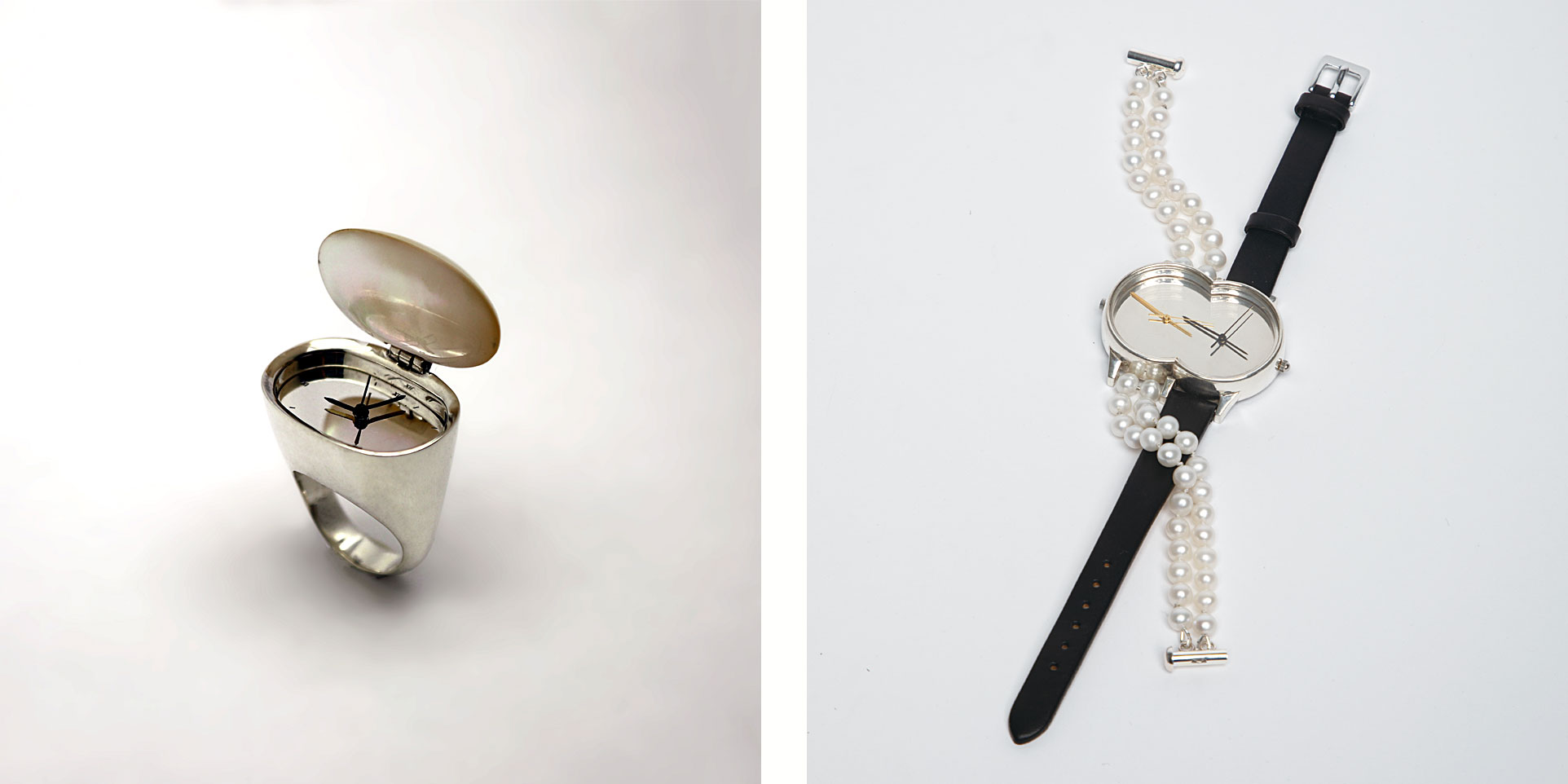
Image 1: Pearl watch ring, sterling silver, fresh water pearl, watch movement, Hwajung Yoo
Image 2: Dual watch, sterling silver, fresh water pearls, calf strap, watch movements, Hwajung YooAnother artist, Lee, photographed her different selves belonging to various subcultural groups in the United States in her work 'Projects'. Through her drastic transformation, I felt the homogeneity and alienation of cultural identity with them. This led me to use only one material, the pearl, to express various selves in different colours and forms.
Winterson: The forms you are exploring are an elegant play on traditional jewellery shapes. Is there a reason for that?
Hwajung Yoo: There are a vast amount of different people and styles in this world. However, traditional jewellery has a base that audiences can think of in common because it has an accumulation of images and perspectives for the wearer. I felt that if I added the watch's movement to this, I could more effectively convey vitality to these contexts.
Winterson: The Ticking Pearls Necklace is an extremely complex piece, and yet is such a beautiful, simple idea. Can you tell us how you arrived at the design?
Hwajung Yoo: The second hand has the most noticeable movement amongst the hands of a watch. If anyone looks at a clock and feels impatient, then perhaps this is because of the second hand. It is constantly moving to a different position, sometimes forcing us into action, and by this movement it conveys the power and vitality of the watch.As actual action also defines me, the second hand can also represent the vitality of people's ego. With some experimentation, I've been able to place two pearls, traditionally representative of femininity, on a second hand of a watch. The pearls rotate every second and create a living elegance. I was able to develop several designs based on this concept.
I also made the gold background metal simple, so as to hide the watches' movements. I wanted people to focus on the pearls until they made a single line and the perfect pearl necklace every minute. I found this to be not so simple to implement in practice due to uncertainty and complications. Nevertheless, it was a valuable challenge to learn a lot.
Winterson: What inspired you to use pearls in this work?
Hwajung Yoo: The pearl is one of the traditional materials that represents femininity, so I wanted to use its historical value to communicate with the audience. In addition, my projects often use pearls as a medium to describe people themselves or their egos. Unlike diamonds and gemstones, the pearl is opaque, so you can't see inside. Nevertheless, it has a beautiful colour slightly different from the subtle background colour. I thought people's invisible and latent souls were similar to these pearl features.
Winterson: What's next for you?
Hwajung Yoo: In the short term, I will further develop this collection to show my style and make it wearable daily, whilst breaking away from traditional jewellery shapes. In the long term, I want to keep creating empowering jewellery to encourage people to look at their egos and consequently have more confidence in their lives. -
Roni Levy, winner of the Winterson Prize 2021
Roni Levy, winner of the Winterson Prize 2021
The winner of this year’s Central Saint Martin’s Winterson Prize is Roni Levy, a designer whose isolation in her apartment sparked an extraordinary journey of reimagining humble materials.
Inspired by the onion’s natural architecture, the collection 'Revealing' tells a story about layers of hidden meaning and story. Painstakingly recreating exaggerated forms of classical styles, Roni has created a collection of exquisite poetry, and it was her oversized pearl necklace, created in white onion skin, that captured our attention from this year’s crop of fantastic design talent.
“My references stem from classical jewellery styles, commercially defined patterns and materials in an exaggerated fashion,” says winner Roni Levy. Visiting the abundant greengrocers along a stretch of North London streets, Roni daily collected the waste onion skins from the base of the display baskets.

“The discarded onion skins dissipate into a translucent material that is both biodegradable, durable and lightweight,” says Roni. “Seen at first as a benign and forgotten resource, I hoped within my practice and throughout this process of discovery to question pre-existing concepts of luxury.”
Using the veneer of the skins, whilst reconstituting their own natural colour and qualities, the process is rooted in transformation. A food industry waste product, crafted into alluring jewellery, Roni is a deserving winner of this year’s Winterson prize.
The Winterson prize celebrates the value of design, encouraging the superlative talents of Central Saint Martin’s students to reimagine what might be possible with this most classic of luxury gems.
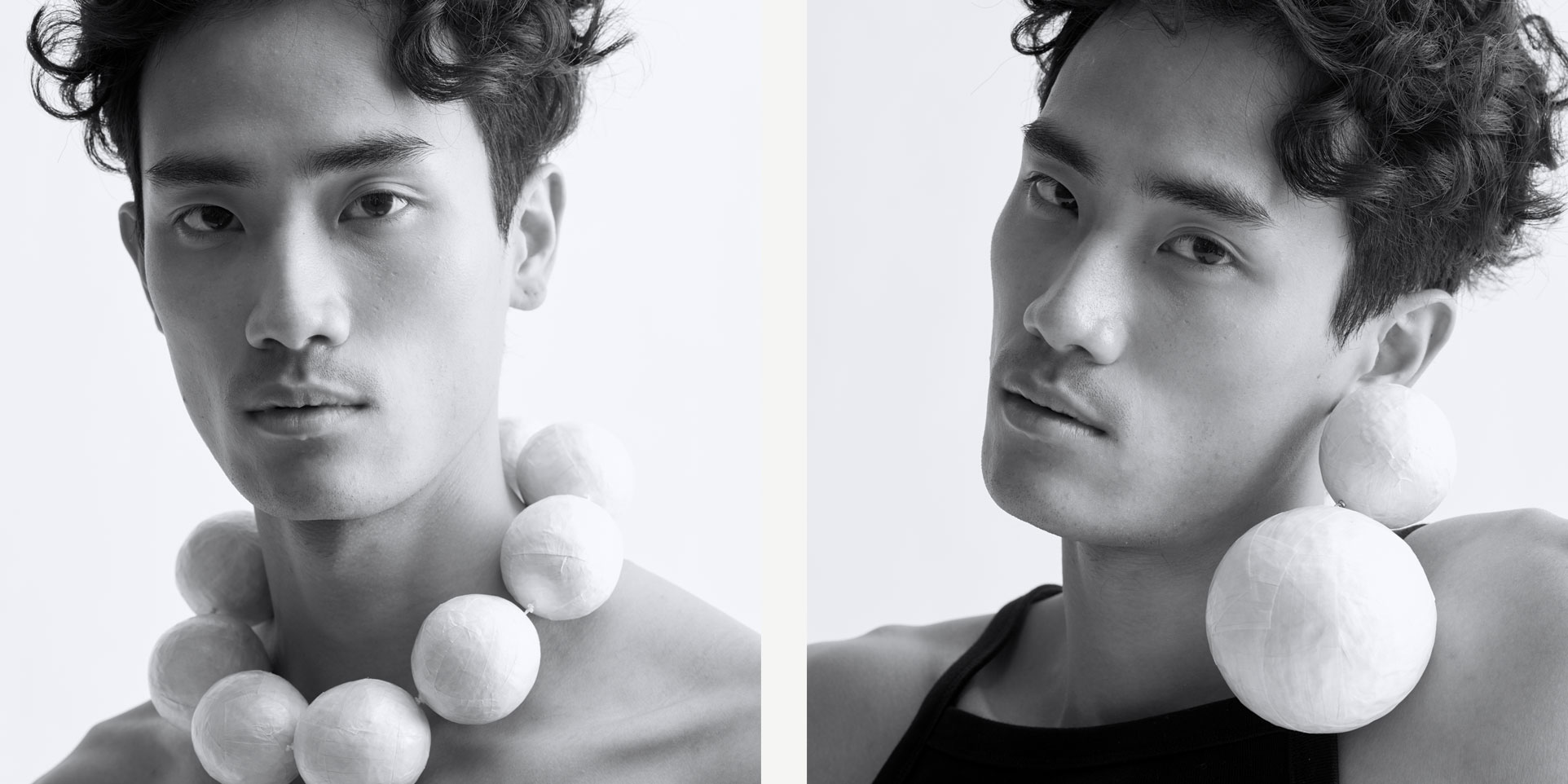
Image 1: Pearl XL dangle earring, white onion skins, silk thread and recycled white metal, Roni Levy
Image 2: Pearl necklace, white onion skins and recycled white metal, Roni Levy
Andrew Fraser, Director at Winterson, commented, “We are delighted to be working again with Central Saint Martin’s BA Jewellery and to be in the wonderful position of having so much great work to consider for this year for the Winterson prize. We loved Roni’s process, the natural material and the alluded to relationship (maybe unintended) between the layers of the onion and the layers of nacre on a pearl. The colours and texture of her pieces are really quite beautiful.”
Winterson’s Creative Director Alice Cicolini concurs, “Roni is a great winner for 2021, her resourcefulness and innovative thinking combining to create a truly inspiring collection. It's such a difficult design task to reimagine the pearl necklace in a way that is truly unique and Roni has manage to achieve it at such an early stage in her career. We're so looking forward to seeing how her work evolves.”
Giles Last, BA Jewellery Design Course Leader commented "The Winterson award is a wonderful recognition of the innovation, imagination, design and craftsmanship of our students. Roni's work is delightfully conceived, beautifully made". -
Zak Sheinman, Winner of the Winterson Prize 2020
Zak Sheinman, Winner of the Winterson Prize 2020
The annual Central St Martins Winterson Prize celebrates a body of work that takes an innovative approach to the pearl. The 2020 graduate collections featuring pearls were rich with exploration around both the material and the context of this classic gemstone.
This year’s winner, Zak Sheinman, created a series of virtual pieces, encapsulating the unique quality of the 2020 graduate experience. All of the students created collections that had to be launched digitally, whether through video and photography of realized pieces or through 3D rendering.
Zak brought his experience of 3D animation, which he had studied both at school and through You Tube tutorials, to bear on his concept of restoring value to broken jewels.
His 4 minute animation of jewels morphing from one form to another, intersecting with other jewels and with pearls raining down and through them, is captivating and a sensitive reassessment of human error and destruction.
Commenting on the award, Winterson's Creative Director Alice Cicolini said, “Zak's collection encapsulates both extremes of the unique circumstances of the present. On the one hand the collection is entirely virtual and not physically realized as jewellery. On the other, it remains a superlative demonstration of craftsmanship and an exploration of the tactile, poetic and material qualities of jewellery. It really feels like a jewellery collection for our time and perfectly answers the challenge of the Winterson Prize - to innovate with and celebrate this unique gemstone.”
We caught up with Zak over Zoom from his home in Wiltshire.
Winterson: What lead you to explore these themes in your work?
Zak Sheinman: I was inspired by an earring of my own that I was about to throw away, and wondered how I could bring new life and value to something that most people would dispose of. I became fascinated by whether you could transform a jewel from one state to another. I was a street dancer as a teenager, so I’m interested in motion and movement.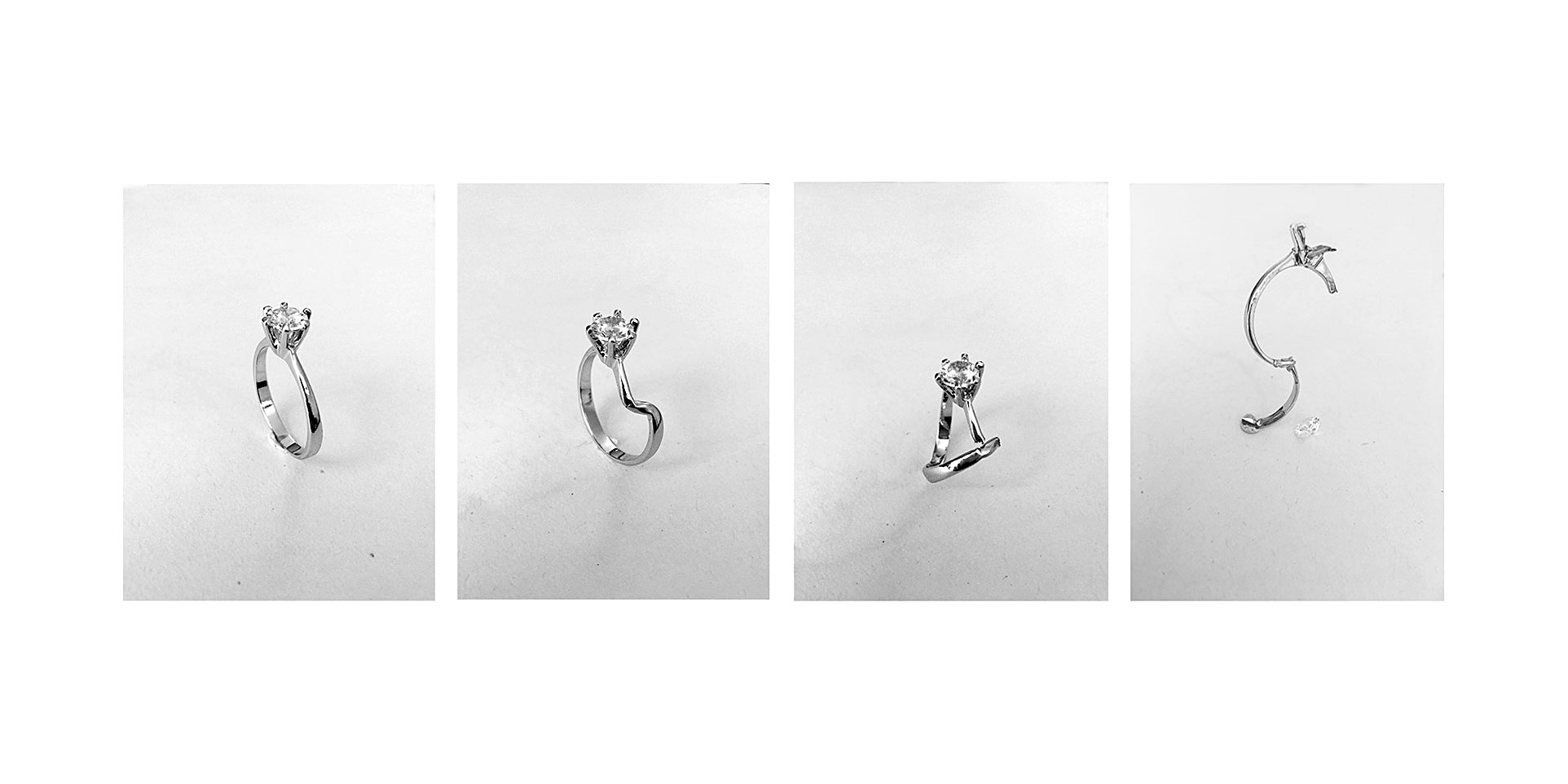
Images: Levels of Damage, by Zak Sheinman
This lead me to look at motion design in jewellery, both from the perspective of using animation to create new forms, but also conceptually to move something damaged from that broken state to something of value. How things become damaged is also a narrative part of the life of a piece of jewellery, and I felt like there was something about the random unexpectedness of animation as a medium that connects with that poetry.
Winterson: Were there other sources of inspiration for you?
Zak Sheinman: I have always loved Tom & Jerry cartoons and the way everything is so high intensity. The damage and collisions between the two are comedic, but also extreme and I wanted to bring some of that energy to my work.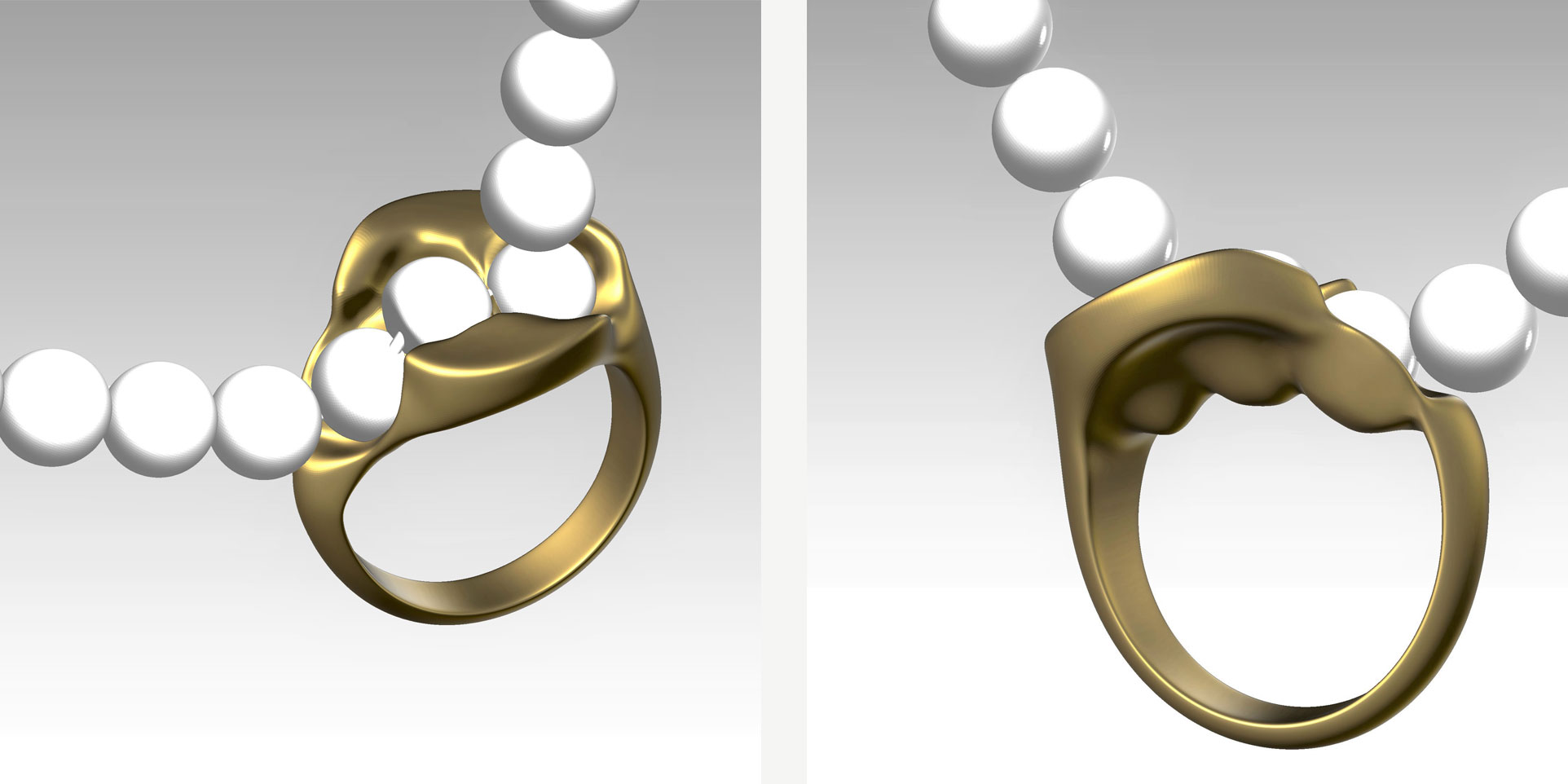
Images: Proposals for Necklace, by Zak Sheinman
Winterson: The forms you are manipulating are quite traditional. Is there a reason for that?
Zak Sheinman: I use traditional forms so that the audience has an instant recognition of what the jewels would have looked like before they were manipulated and broken. The fact that the material then moves and behaves in a way that it shouldn’t is easier to read and understand than if the objects themselves were also conceptual. This is different to what most people understand jewellery to be.
Winterson: What inspired you about using pearls in this work?
Zak Sheinman: I was looking at this idea of challenging people’s perceptions of materials and how they behave. As an instantly recognisable gem, the pearl was also a perfect vehicle for that. Pearls are a delicate gemstone, and yet in this piece they collide with and influence the shape of the metal, a material that is naturally so much stronger.
Winterson: Congratulations on winning the Winterson prize this year! What is next for you?
Zak Sheinman: I’m really excited about the potential of using animation as a driving force in my design. There’s a detail and a story in each frame that feels rich and inspiring. This is also a great way to create bespoke, unique pieces for clients using each frame as a potential starting point for creating a new jewel. -
La Peregrina - Famous Pearl Jewels
La Peregrina - Famous Pearl Jewels
The legend of La Peregrina, one of the world’s most famous natural pearls, suggests that it was found in the mid-16th century near the island of Santa Margarita in the Gulf of Panama by an African slave, who was rewarded for his find with freedom.
At the time this extraordinary pear-shaped pearl was also one of the largest ever found, measuring approximately 17.5mm by 25.5mm and weighing over 11 grams before it was cleaned and drilled.
Don Pedro de Temez, the administrator of the Spanish colony, recognised the pearl's importance and brought it to Spain, where he gave it to the future king - Philip II of Spain. At this time the pearl began an incredible journey of ownership and it remains today one of the oldest and best documented historical jewels.
Philip presented with La Peregrina to Mary I of England, his future wife. Mary wore the pearl as a pendant suspended from a brooch, a jewel she can be seen wearing in a series of portraits from the period. After Mary’s death in 1558, the pearl was returned to the Spanish court where it remained for 250 years, and was worn by the wives of Kings Phillip III and IV.
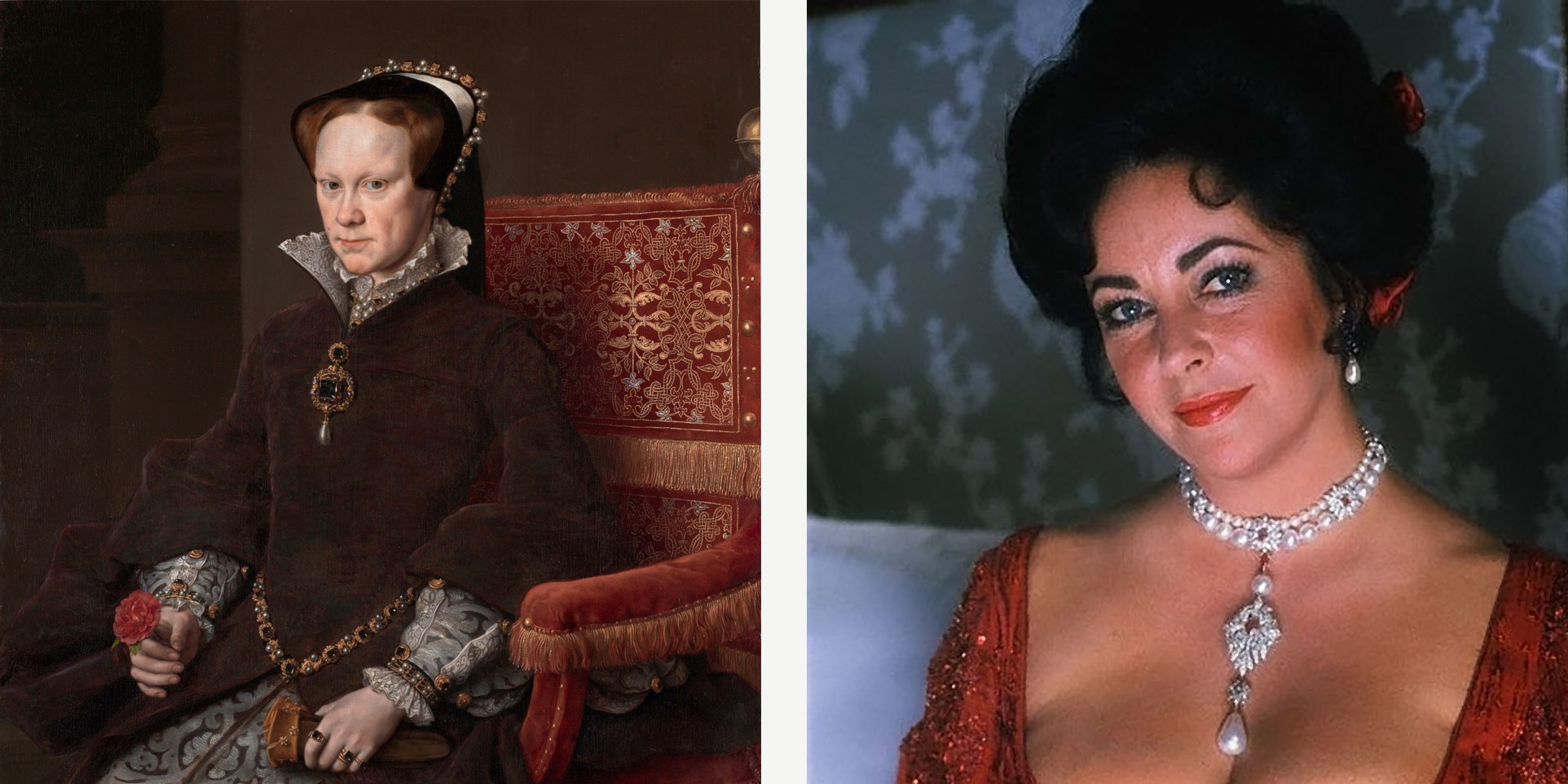
Image 1: Mary Tudor, original artwork by Antonis Mor 1519-1575
Image 2: Elizabeth Taylor, c.1972
In 1808, when Napoleon installed his brother Joseph Bonaparte as King of Spain, the pearl found its way to France. In 1848 the pearl finally made its way to England into the Estate of James Hamilton, Duke of Abercorn. It was during this time it was given the name La Peregrina, which means the “Pilgrim” or “Wanderer”.
La Peregrina remains one of the largest perfectly symmetrical pear-shaped pearls in the world. The Hamiltons sold the pearl for $37,000 at Sotheby’s in 1969 to Richard Burton, as a Valentine Day's gift for Elizabeth Taylor.
It was the exquisite heirloom that sealed one of Hollywood's most tempestuous love stories. Drop and pear-shaped pearls are often made into pendants, but during its history La Peregrina was worn as a brooch, a pendant to a necklace, the centrepiece of a necklace and even a hat ornament. Taylor commissioned Al Durante of Cartier in 1972 to design a ruby and diamond necklace mount for the pearl. The complete piece is quite stunning and truly one of a kind.
When Taylor died, La Peregrina was sold at auction by Christies in 2011 to raise funds for the Elizabeth Taylor AIDS Foundation, which was established by Taylor to help provide direct services throughout the world for people living with AIDS.
Christies estimated the value of La Peregrina to be between $2 million and $3 million, making Lot 12 the second highest valued lot of the auction. In a fitting tribute to the memory of Elizabeth Taylor, the auction of legendary jewels surpassed all expectations, with the sale of La Peregrina for $11,842,500 creating two new world auction records for a historic pearl and for a pearl jewel.
Where, we wonder, will the next stage of its historic journey be taking the Wanderer to? -
Juntao Asa Ouyang, Winterson Prize 2019
Juntao Asa Ouyang, Winterson Prize 2019
Juntao Asa Ouyang was announced as the winner of the 2019 Winterson Prize for the Best Use of Pearls at Central Saint Martins, London last night, where degree collections from jewellery's future stars went on display.
The influential arts institute’s annual graduate show saw students presenting original pearl pieces, created with advice and support from Winterson Director Andrew Fraser and Creative Director Alice Cicolini.
Asa was named this year’s winner of the Winterson Pearl prize for her collection 'Glitch', which explored the fusion between traditional Chinese lacquer work and a 21st century dependence on technology. The collection used a combination of abalone mother of pearl, known for its vibrant tones of blue, green and purple, and freshwater pearls nestled in ears as futuristic wireless headphones with a playful design aesthetic.
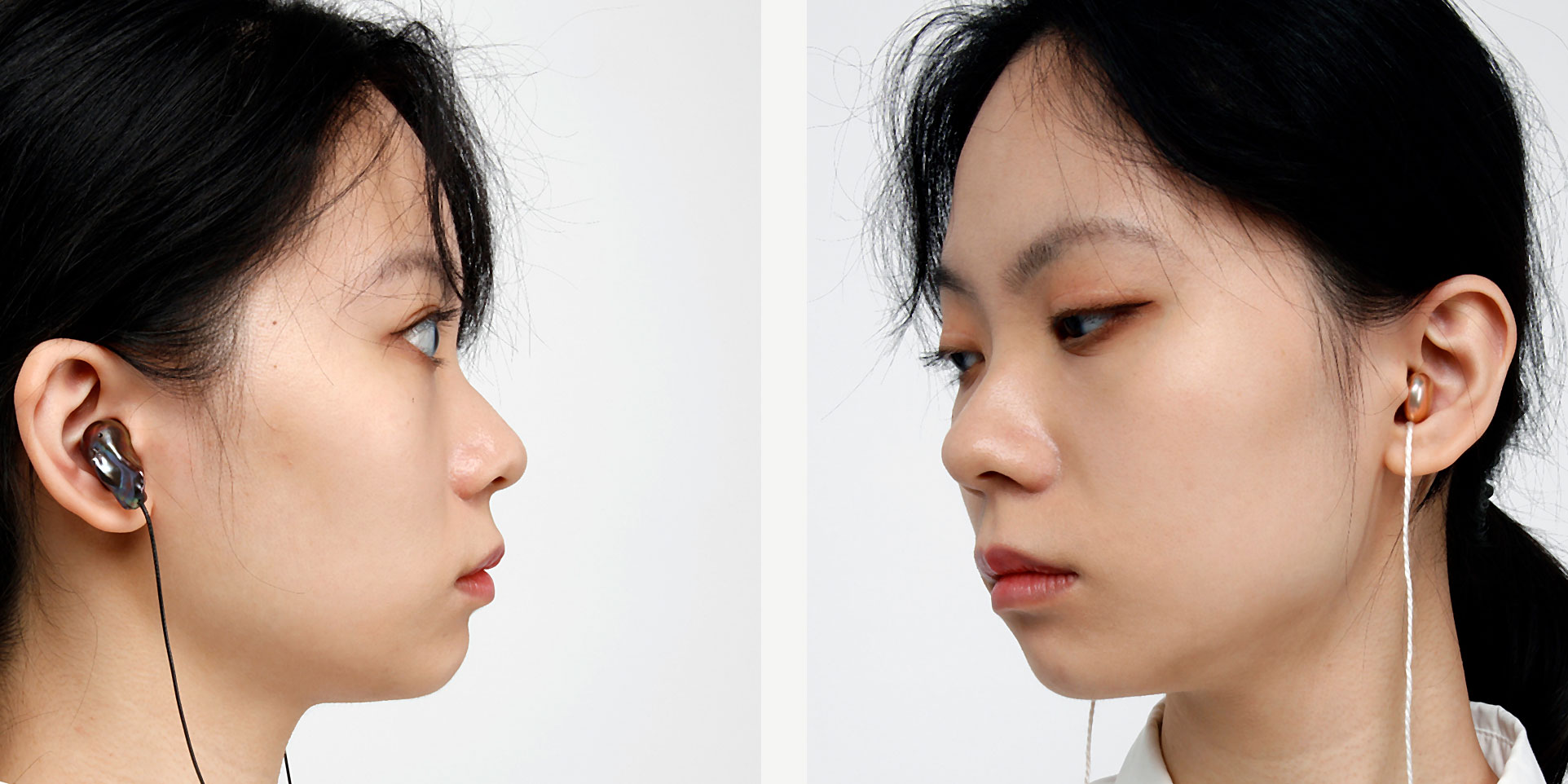
“I am extremely honoured to receive the Winterson Prize. Pearls are astonishing to work with,” says Asa. “The journey of seeking the right pearls for my collection and then arranging and inlaying the mother of pearl is fascinating and exciting. The lustre and colour of pearls are ever changing.”
”Just like the technological glitch, which I explored in my collection, the pattern of mother of pearls is never the same. Lacquer and mother of pearl will be the foundation of my work in future, further exploring traditional craft techniques in contemporary jewellery,”
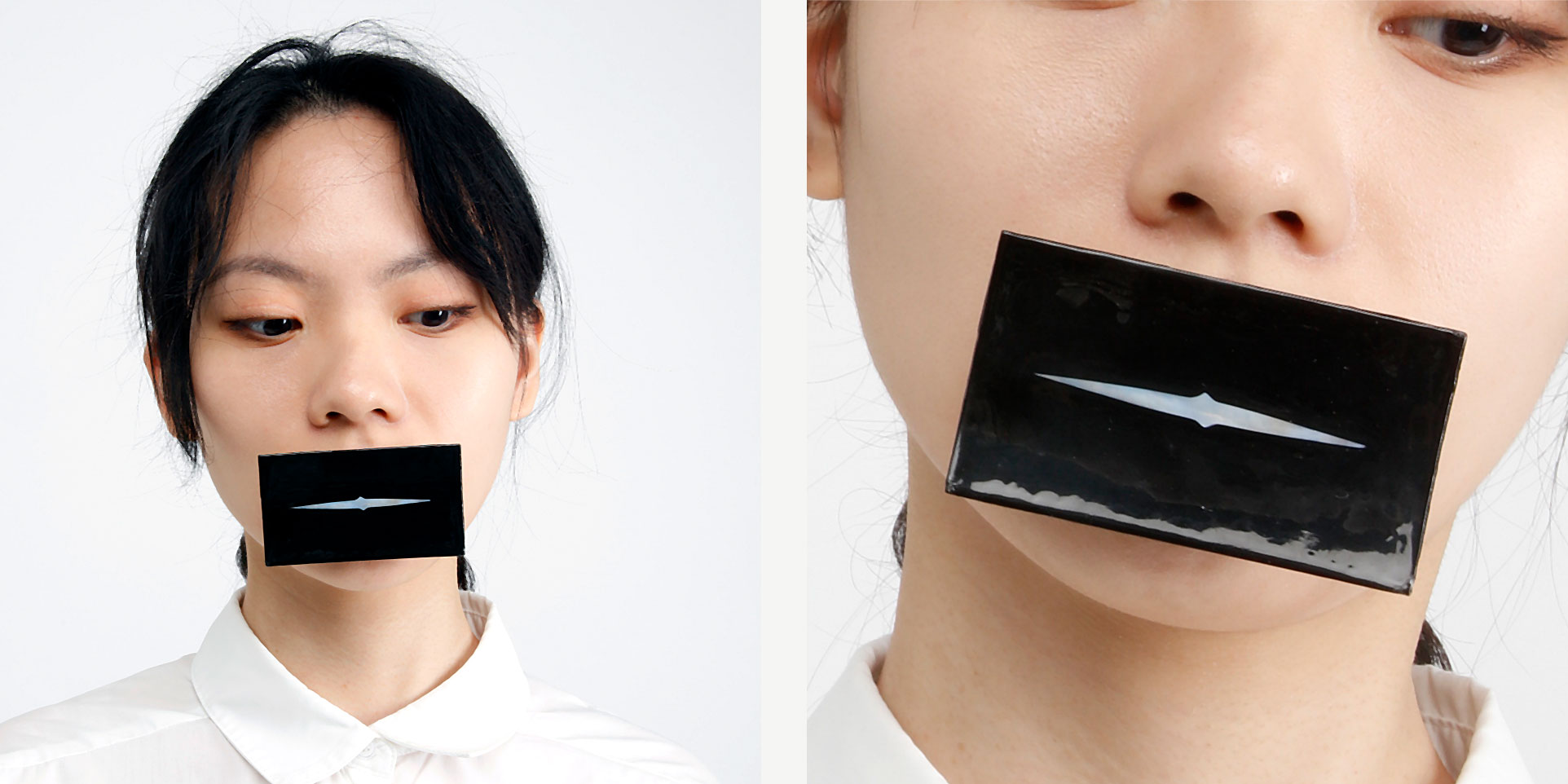
Giles Last, BA Jewellery Design Course Leader commented ”Asa has created a unique, experimental and fascinating collection, exploring methods of communicating a critique of over dependence on technology through jewellery.”
”The pieces, using the traditional materials and techniques of mother of pearl and lacquer, question what we do and accept as the norm in the 21st century whilst celebrating traditional making techniques and materials. A delightful and intriguing body of work.”
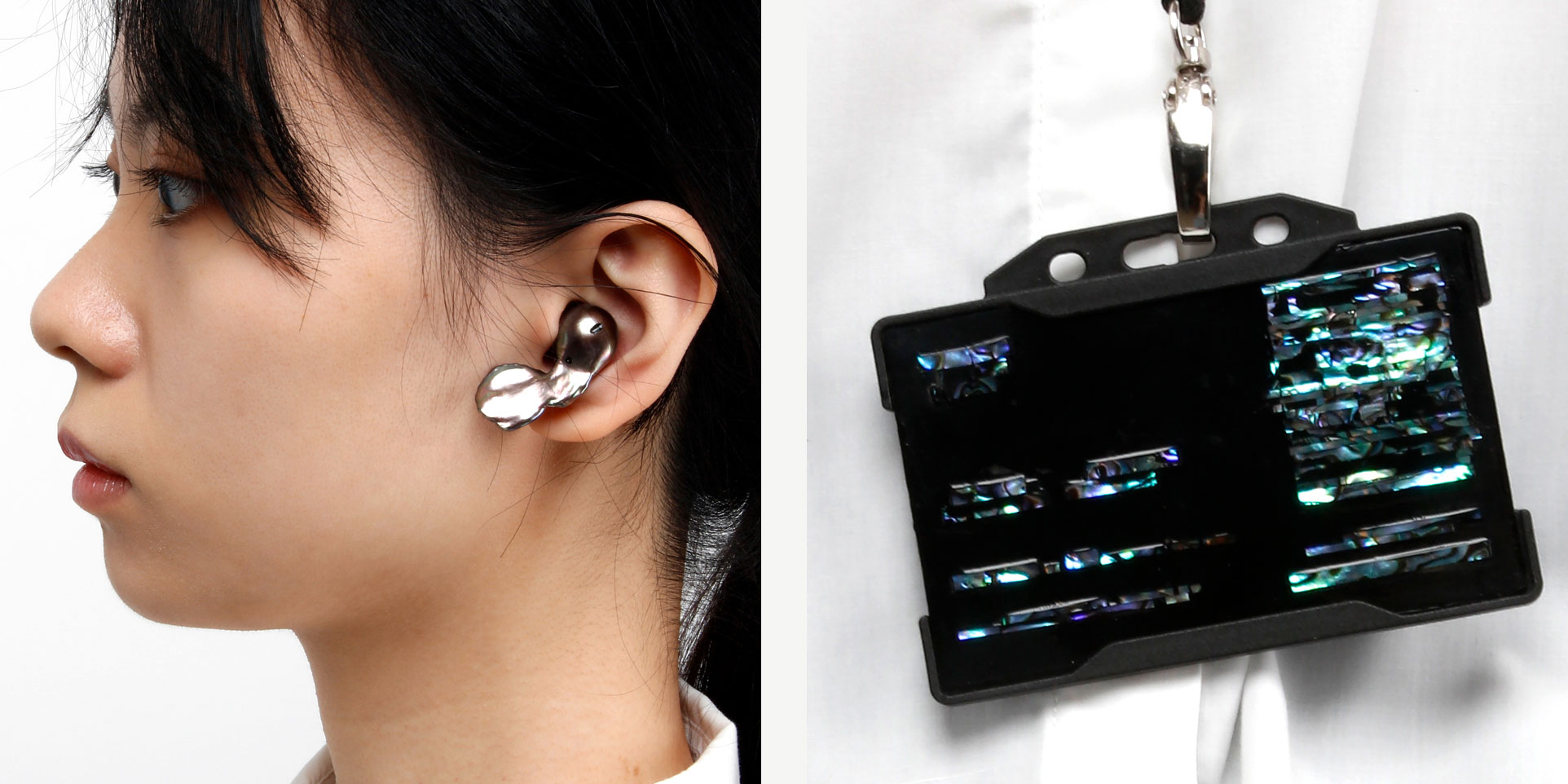
Commenting on the award, Winterson's Creative Director Alice Cicolini said ”We were delighted to see Asa’s work with the ancient traditional technique of lacquer inlay, putting it to use in creating a futurist and thoughtful collection.”
”Asa’s work uses the stunning iridescence of abalone mother of pearl to reference the technological glitch, giving the material new life and meaning in a group of work that questions our relationship to screening and surveillance, and its distancing from the natural and tactile world. Asa is a worthy winner of the prize for innovation with pearls. Congratulations Asa!”
Read more about Juntao Asa Ouyang and the other CSM designers' work here. -
Winterson Prize 2019: Meet the Designers
Winterson Prize 2019: Meet the Designers
Each year we work with the student jewellery designers at Central Saint Martins in London, giving them an opportunity to experience designing with pearls for their final year collections.
We will be awarding the Winterson Prize 2019 to one of the students for ‘The Best Use of Pearls’ at the CSM Jewellery Awards Evening on 20th June. The BA Jewellery graduate collections are exhibited at CSM and open to the public from June 19th - 22nd.
Here we feature the first part in a series of short interviews with designers from the CSM Jewellery 2019 show, including in this article - Ayse Daga, Diana Jung, Fermin Cheung, Hao-Yang Lai, Juntao Asa Ouyang and Wen-Ju Tseng.
Read about Juntao Asa Ouyang, the winner of this year's prize.
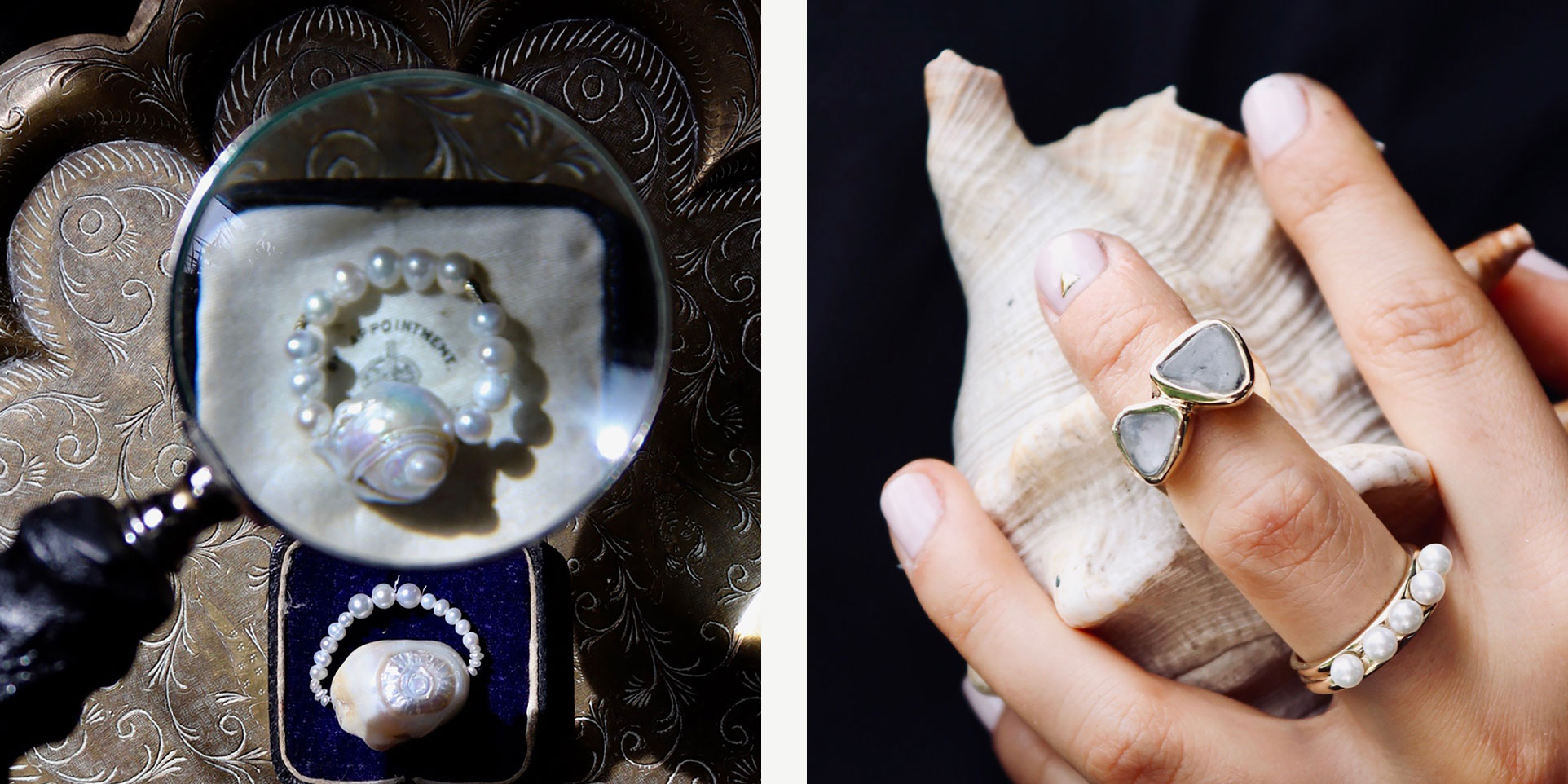
Ayse Daga
Tell us a little bit about yourself.
I have been passionate about creating since I was very young. Starting off with drawing and painting, I realised that I am interested in creating three dimensional forms that can either be personal or that communicates ideas in a broader sense. My main inspiration is history and admiration of different cultures around the world. Based in Istanbul, Turkey, I believe my interest for different cultures and history come from the rich historical past, traditions and crafts of my home country.
What was the inspiration for your Faces from Curiosities collection?
From broad to narrower sense, it was, history, culture, memories and human conscious. Cabinet of curiosities and Sigmund Freud’s collection of objects were two main inspirations for me to build up a starting point for my collection.
What do you find inspiring about pearls?
Definitely their roots and history. They are considered as the worlds’ oldest gems and were used for different purposes in different cultures. I am also very interested in their nature. Unlike gemstones that are mined from the earth, a living organism produces a pearl.
What have you discovered about working with pearls?
They are easier to carve compared to other stones. I also realized the interesting nature of the Baroque pearls. Their natural and irregular shapes are very inspirational.
Which designer or artist do you most admire?
Shinji Nakaba and Sevan Bıçakçı (he doesn’t use pearls a lot).
Who could you imagine wearing your jewellery?
To be honest anyone could wear my jewellery who appreciates the idea of history and culture. I always admire ancient tribal jewellery and consider myself as a maker and designer who reinterpret the idea of authenticity.
What’s next for you after CSM?
I’m planning to develop myself in terms of carving and engraving and hopefully expand my work to create my own business.
View more of Ayse's work here.
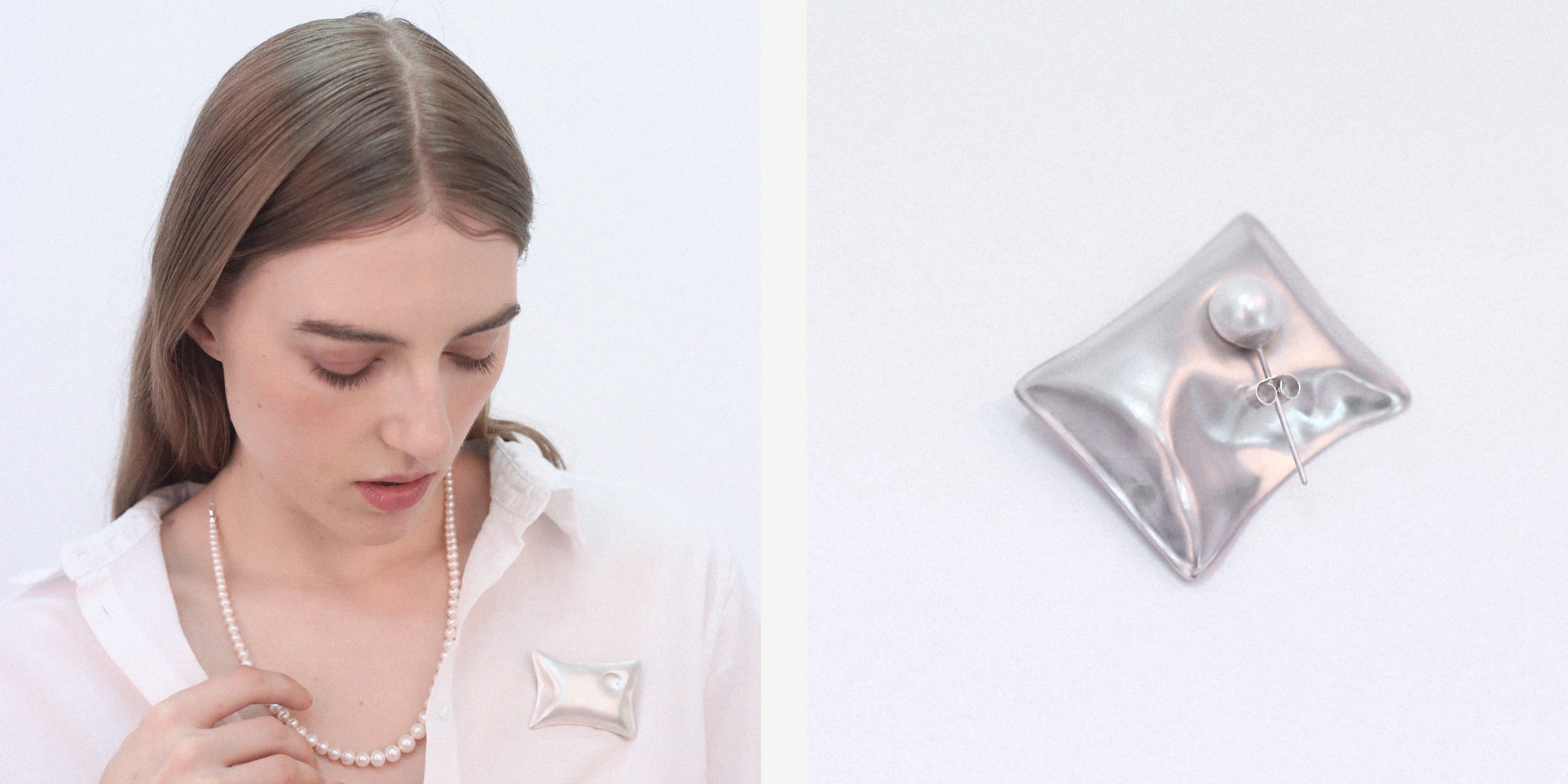
Diana Jung
Tell us a little bit about yourself.
My jewellery designs result in numerous attempts of embodying my delicate sensations into objects. I like designing sculptural pieces that are beautiful when they are both worn and not worn, which holds the features of both art jewellery and fine jewellery.
What was the inspiration for your Sense of Belonging collection?
Exploring the scenes of laundry, the subtle image of soft pillows hanging on the laundry lines left a strong impression on me. Pillows itself are such a symbolic object of home and a personal possession that remains nearest to the skin. Having something that exists in one’s private space and moments set out to the public, came upon as an unusual but also beautiful sight for me. Therefore, I decided to create a collection of puffy pillows which contains the nostalgia of one’s comfort place to be worn on the body for people to see.
What do you find inspiring about pearls?
I love the white soft texture of pearls. I find pearls fascinating in that they have such a calming, comforting look to them. I also think that pearls are special because they become heirlooms that can be cherished for a long time.
What have you discovered about working with pearls?
I found that pearls could be carved and transformed into various shapes. However, I eventually came to realize that pearls are the most beautiful when it is in its pure state.
Which designer or artist do you most admire?
Sculptor and installation artist Do Ho Suh, Rachael Whiteread, and fashion designer Pheobe Philo.
Who could you imagine wearing your jewellery?
I imagine my jewellery being worn by anyone who can relate to my pieces and understands the sensitivity of them.
What’s next for you after CSM?
I really enjoy designing and making jewellery and would love to start working in other companies. Eventually, I would like to have my own brand.
View more of Diana's work here.
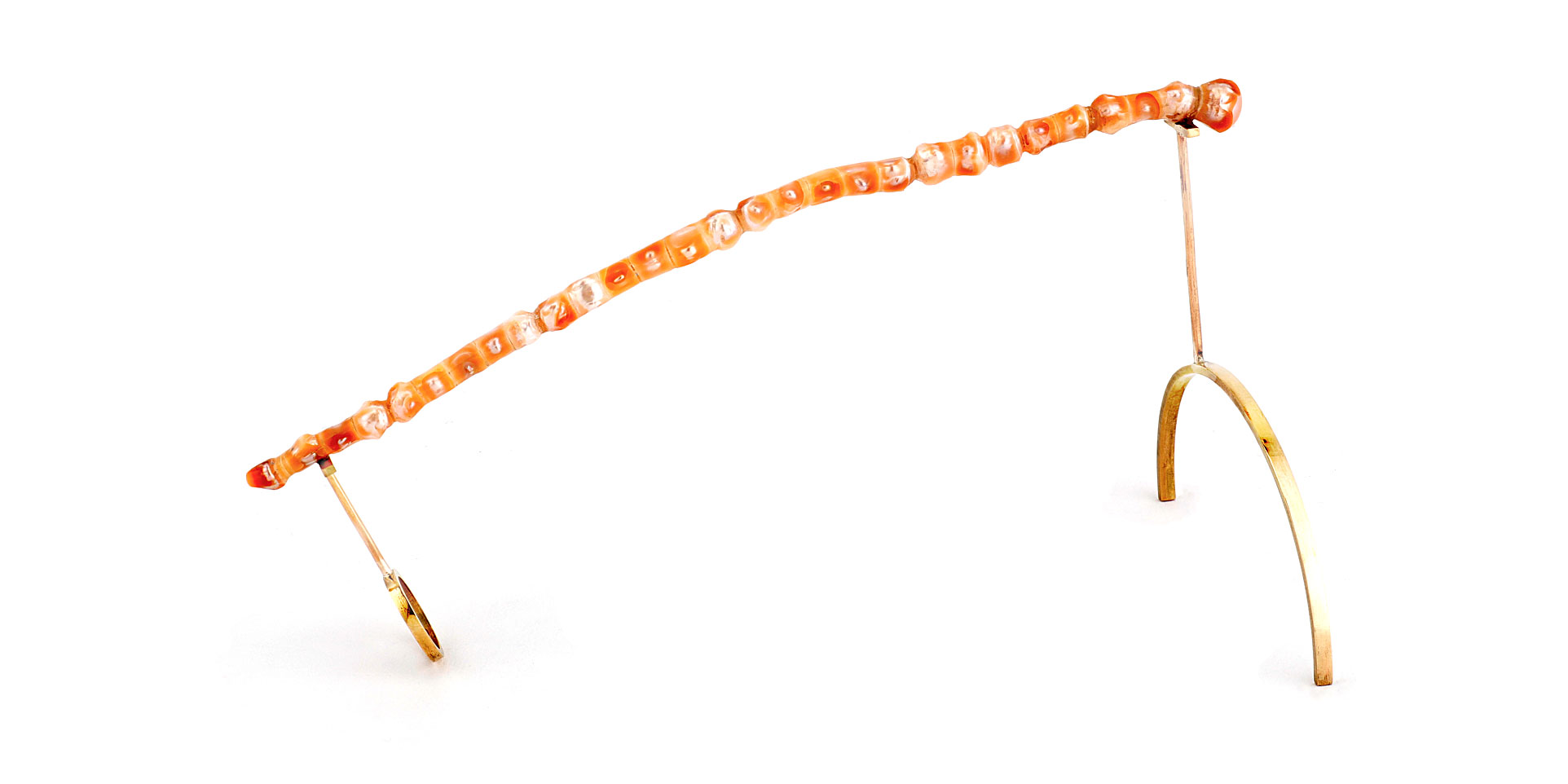
Fermin Cheung
Tell us a little bit about yourself.
Someone who likes drawing, painting and crafting but doesn’t understand contemporary arts.
What was the inspiration for your Vitana collection?
Shinji Nakaba who is a Japanese artist specialise in pearl carving; anatomy studies that I’ve been revising in my spare time and my essay which did some research on display methods in galleries.
What do you find inspiring about pearls?
The softness of the material is inspiring. Not just in its strength but also the visual that looks like layers of airbrush stacked on top of each other, creating a vibrant colour. The resin-like interior is also intriguing.
What have you discovered about working with pearls?
The properties of having layers in pearls which cause problems during carving; possibility of sculpting as the material is capable to provide contrast between hard edges and soft edges.
Which designer or artist do you most admire?
Shinji Nakaba; Neil Linnsen, Jiro Jur, Wlop and Shal_E.
Who could you imagine wearing your jewellery?
Audience that not only appreciate the visuals of a piece, but also appreciate the intentions or messages behind.
What’s next for you after CSM?
Utilising the degree and work for income, whether it is contemporary or commercial jewellery or any other aspects, supporting the study in illustration and concept art, potentially animation if time allows.

Hao-Yang Lai
Tell us a little bit about yourself.
I’ve always been interested in designing and making since I was young. As I begin my further studies at Central Saint Martins, I was very lucky to be in a position to truly explore myself. To me, jewellery is about challenging conventions and breaking boundaries. In the future, I intend to continue pushing my designs further and bring awareness to the social issues that I care deeply.
What was the inspiration for your Anthropocene collection?
The starting point of this collection was inspired by science fiction and the cyberpunk movement. As I developed my concept, I begin to realise how science fiction reflects our society and how it can inform my work. With science fiction movies like Blade Runner 2049 (2017), I was heavily inspired by imageries of the postmodern, apocalyptic world. My collection found itself inheriting many characteristics such as the cybernetic forms and clean design aesthetics from the film.
What do you find inspiring about pearls?
I think what’s most interesting about pearl is that they are natural forms. With my collection, I investigated with the relationship between man-made verses nature. The contrast between pearls and the artificial stone gives a new dimension to my collection.
What have you discovered about working with pearls?
I’ve discovered pearls have interesting qualities, such as the different reflections and colours, it's soft on the outside and hard in its core.
Which designer or artist do you most admire?
Anish Kapoor, Stanley Kubrick, Richard Serra
Who could you imagine wearing your jewellery?
Artists, collectors, designers.
What’s next for you after CSM?
I’m probably moving to Africa or South America to do volunteer work.
View more of Hao-Yang's work here.

Juntao Asa Ouyang
Tell us a little bit about yourself.
I am a passionate designer who works with traditional craft skill and wants to interpret craft skills, craftsmanship in contemporary jewellery.
What was the inspiration for your Glitch collection?
My inspiration comes from the circumstances of people over-reliance on technology products. What would happen if all the technology that people depend on just shuts down? I aim to demonstrate the fear of how daily used technology may ‘Incorporate’ people if people rely too much on technology.
What do you find inspiring about pearls?
The uniqueness and colors of pearls is pretty inspiring.
What have you discovered about working with pearls?
I used mother of pearl and pearls in my collection. Colors of abalone shell can represent glitch screens in an abstract way. Natural baroque pearls come with different sizes and shapes. Seeking the right pearls for my collection is an interesting journey.
Which designer or artist do you most admire?
Theo Jansen and Gijs Bakker.
Who could you imagine wearing your jewellery?
People who like to warn themselves from over-reliance on technology products.
What’s next for you after CSM?
I would like to find a job in which I can learn while working.
View more of Juntao's work here.
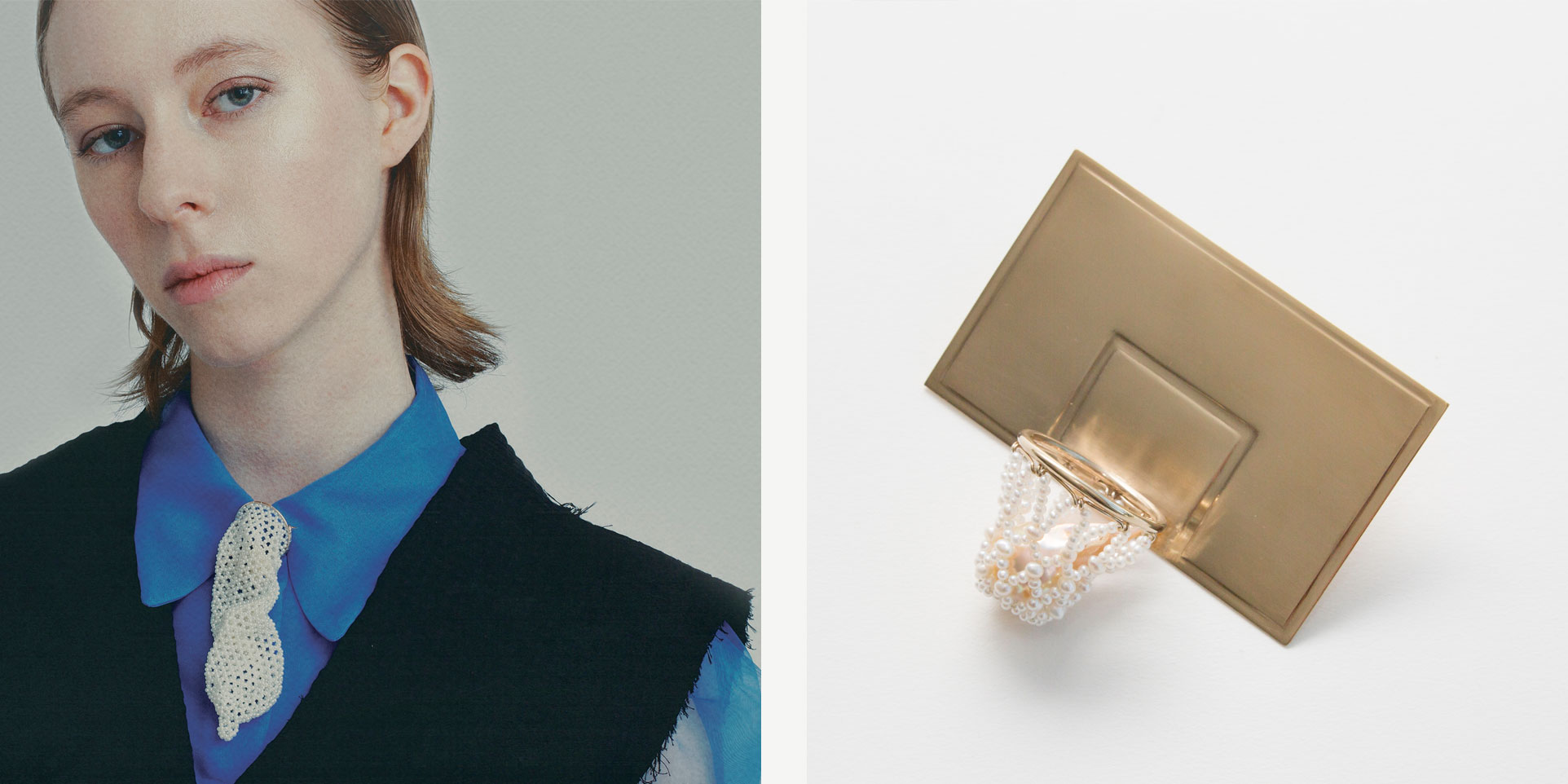
Wen-Ju Tseng
Tell us a little bit about yourself.
I am an enthusiastic and bubbly person who tends to overcomplicate things but always finds a way to simplify them again.
What was the inspiration for your How Valuable Are You collection?
Social expectations have forced us to constantly evaluate and assess individuals. The collecting and processing of basic personal information provides a system for measuring one’s value that is quietly going out of control. My final collection subverts the uses of everyday objects to challenge how societal expectations are creating a worrying trend to commodify everything we do into unrealistic values.
What do you find inspiring about pearls?
Pearls have a unique lustre that makes them stand out in the crowd of jewels.
What have you discovered about working with pearls?
They come in all different sizes, colours and shapes and I really do mean it. I would like to thank all the living shell mollusks that created the mini pearls I used in my collection.
Which designer or artist do you most admire?
I don’t have one favourite designer but I do have quite a few designers and artists who inspire me such as Ken Price, Ai Wei Wei, Shaun Leane, Gijs Bakker and Margiela.
Who could you imagine wearing your jewellery?
You.
What’s next for you after CSM?
Expand my collection by developing showpieces into everyday wearable pieces and look into other aspects of social expectations!
View more of Wen-Ju's work here. -
The Hope Pearl - Famous Pearl Jewels
The Hope Pearl - Famous Pearl Jewels
From time to time in The Journal, we explore the origins and stories around famous pearls and items of pearl jewellery. In this article, we continue to share our fascination for this most stunning of gemstones, with the extraordinary Hope Pearl.
Believed at the time to be the largest natural saltwater pearl ever discovered, the Hope Pearl was named after its owner Henry Philip Hope. Hope (1774-1839) was an Anglo-Dutch gem collector, who acquired many renowned gemstones and diamonds for his collection, including the famous blue Hope Diamond and approximately 148 natural pearls of significant size.
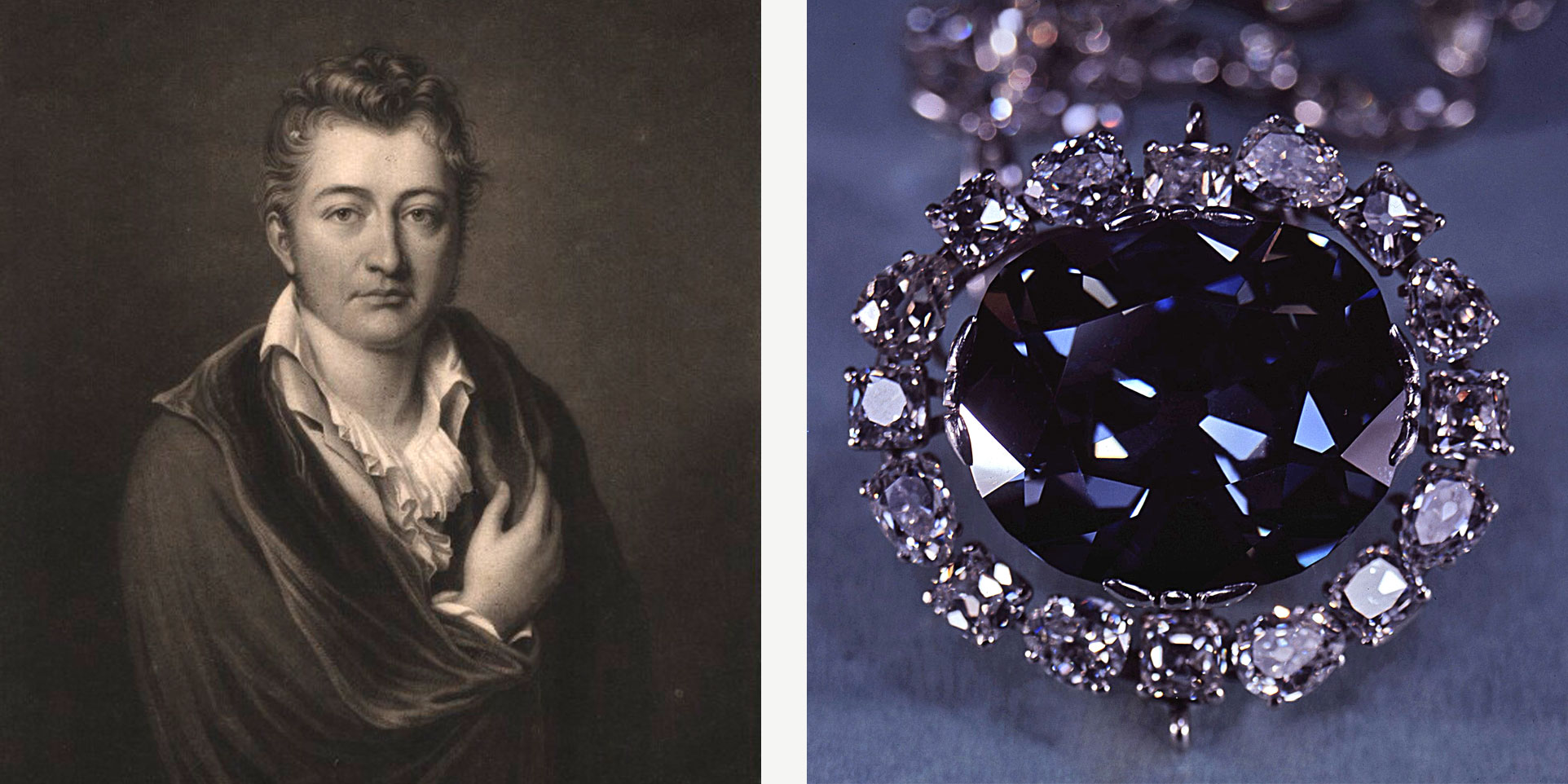
Image 1: Henry Philip Hope, by Thomas Goff Lupton, after Bouton, 1823
Image 2: The Hope Diamond
The Hope Pearl was one of Henry Philip Hope’s first acquisitions as he set about building his collection of gems and jewellery. The Hope Pearl was believed to have been possibly acquired by Tavernier and sold to King Louis XIV in 1669, before being subsequently sold to Hope, around 1795. The pearl was included in a catalogue of his collection that was published by Bram Hertz in 1839, the year that Henry Philip Hope died.
Its exact origin is unknown, but it is likely, given the period when it was discovered, that the Hope Pearl was an ‘oriental’ pearl. It was perhaps found in the Persian Gulf, the Red Sea or the Gulf of Mannar between India and Sri Lanka, which were the traditional centres of the pearl fishing industry for over 4,000 years.
Weighing around 1,800 grains (or 450 carats), the Hope Pearl is a blister pearl. The pearl would have formed on the inner surface of the mollusk's shell. This location is still visible on the surface of the gem, although it has been polished to resemble other parts of the pearl’s surface.
It is its size and cylindrical drop shape that makes this pearl so unusual. Natural blister pearls are thought to form as pearls within the mollusk's mantle tissue, before breaking free and being pressed into the shell. Cultured blister pearls today are usually hemispherical, with a layer of mother of pearl being used to create the flat back of a mabe pearl.
Measuring approximately two inches by four inches, and ranging in colour from greenish-gold on one end to white on the other, the Hope Pearl contributed significantly to an explosion of interest in baroque pearls and baroque pearl jewellery in the late 16th to 17th centuries.
The popularity of baroque pearls stemmed from their unique qualities of shape and colour, with master jewellers creating extraordinary gems in forms that the pearls themselves suggested. The Swan Pendant, now at the Hermitage State Museum in St Petersburg, and The Canning Jewel, part of the Victoria & Albert Collection, are two of the most famous examples.
Hope had the pearl mounted in a pendant setting in the shape of a crown, and featuring rubies and diamonds. Now in private ownership, the Hope Pearl has been exhibited internationally including at the Natural History Museum in London and the Smithsonian in New York. -
Introducing the Mythologie Dewdrops
Introducing the Mythologie Dewdrops
New to the Mythologie collection is the refined simplicity of the Dewdrop earrings and pendants.
The Mythologie collection is inspired by the legends of the teardrop pearl throughout history. A symbol of new beginnings, pearls make a perfect gift for Christmas and the new year to come.
Celebrating the pearl's history as a symbol of purity, love and wisdom, the elongated drop shape of the design captures the sparkle of morning dew, which some ancient cultures believed was crystallised into a pearl.

Image 1: Mythologie Dewdrop Akoya Pearl Earrings in White Gold
Image 2: Mythologie Dewdrop Akoya Pearl Pendant in White Gold
The Ancient Greeks believed that pearls were the tears of the Gods, and that wearing pearls for a wedding would protect the bride from tears and sorrow. Over generations the pearl’s connections with innocence, beauty and purity have made it the perfect gemstone for a bride.
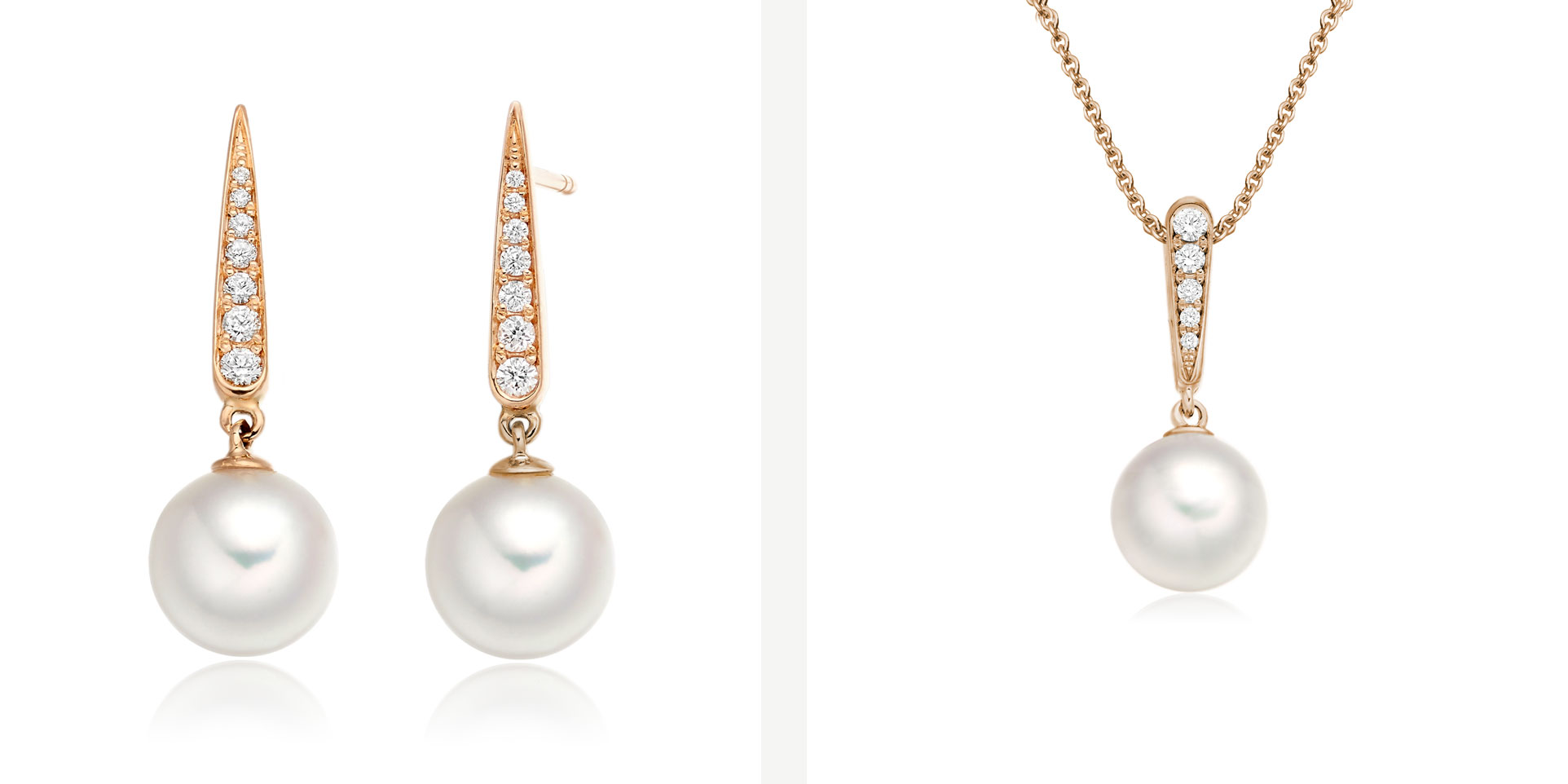
Image 1: Mythologie Dewdrop Akoya Pearl Earrings in Rose Gold
Image 2: Mythologie Dewdrop Akoya Pearl Pendant in Rose Gold
Hindu folklore refers to the pearl as a dewdrop, falling from the night sky into the moonlit sea, where Krishna, the god of love, plucks it from the ocean floor as a bridal gift for his daughter. Show your love for that special someone with a stunning new Mythologie Dewdrop set this Christmas.
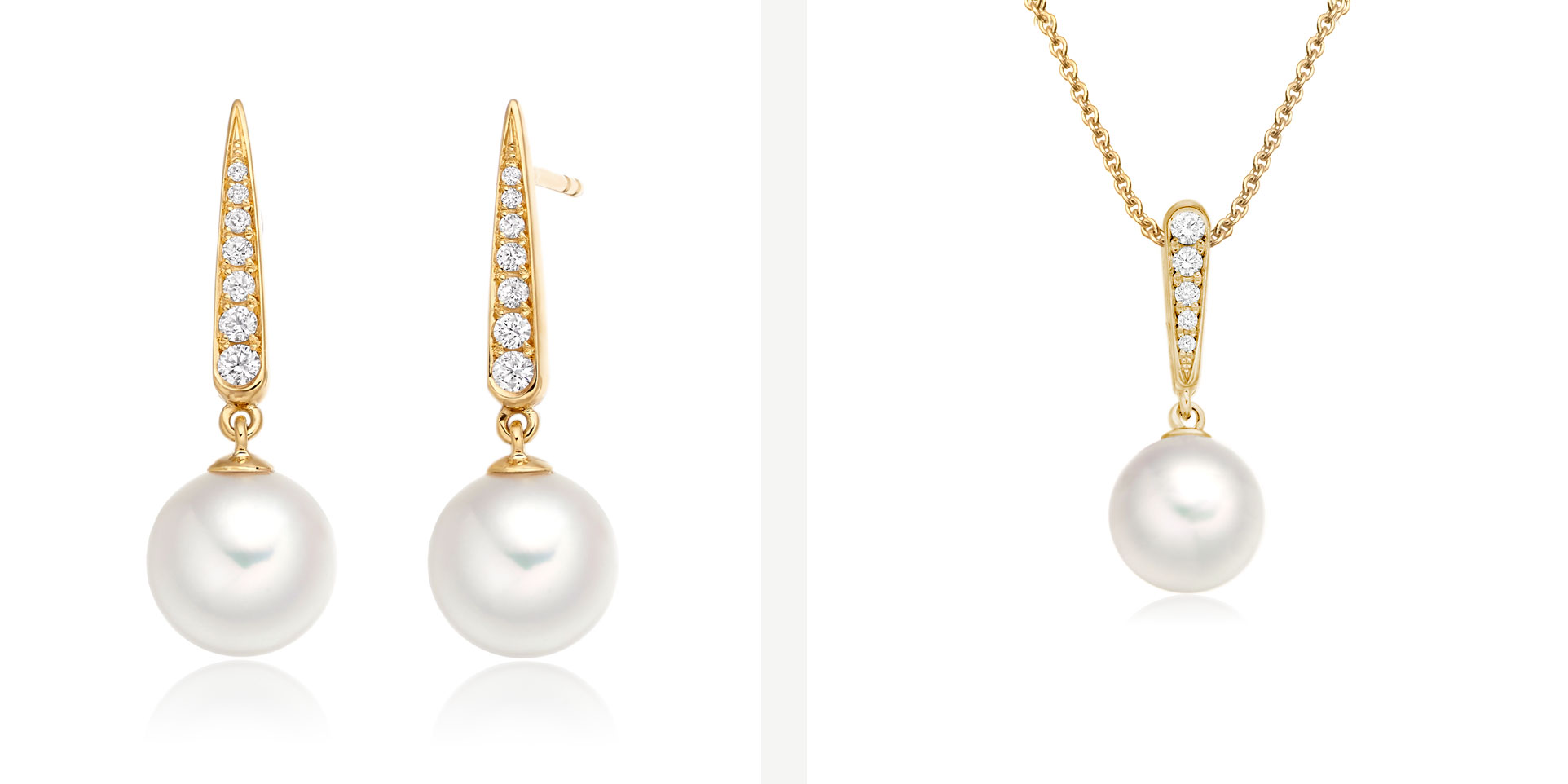
Image 1: Mythologie Dewdrop Akoya Pearl Earrings in Yellow Gold
Image 2: Mythologie Dewdrop Akoya Pearl Pendant in Yellow Gold
Each elegant Dewdrop is crafted with a beautiful Akoya pearl, topped by a pave of brilliant cut diamonds, and hand finished in 18 carat white, yellow or rose gold.
A special Dark Dewdrop design is now also available, with the natural tones of Tahitian pearls that are perfect for the evening. -
Aidan Madden, Winner of the Winterson Prize 2018
Aidan Madden, Winner of the Winterson Prize 2018
Aidan Madden was announced as the winner of the 2018 Winterson Prize for the Best Use of Pearls at Central Saint Martins, London last night, where degree collections from jewellery's future stars went on display.
The influential arts institute’s annual graduate show saw students presenting original pearl pieces, created with advice and support from Winterson Director Andrew Fraser and Creative Director Alice Cicolini.
Aidan Madden was named this year’s winner of the Winterson Pearl prize for his collection of single earrings, each finely crafted from freshwater pearls. Aidan has painstakingly fused together, carved and finely lathe-turned the pearls into a series of gently humorous jewels.

Image 1: Arm, by Aidan Madden
Image 2: Face, by Aidan Madden
Aidan's studs reference pop cultural themes from Disney to Alien, using a gemstone that is more commonly associated with classicism and aristocracy. His craftsmanship and attention to detail gives the results a subtlety and delicacy that ensures his work stands out from similar concepts.
Aidan described his collection to us: “I did not start this project with any preconceptions of the pearl. As soon as I started to cut and join them, their playful pearl faces begin to appear and it seemed that the approach had infinite potential to create a diverse and accessible series of earrings.”

Image 1: Bug Eye, by Aidan Madden
Image 2: Cube, by Aidan Madden
Image 3: Pink and Yellow, by Aidan Madden
Squared studs and alien heads reveal some of the production process behind the creation of freshwater pearls, with visible nacre standing in for ethereal eyes, and the edges of squares retaining the peacock dyes that have been used to colour the pearl.

Image: Pearl Culture, by Aidan Madden
Exquisite carved pearl crowns sit on top of ghostly heads, caterpillars of pearls wrap around to create unique hoops and cartoon characters that are rendered in a fine balance of coloured pearls.
Caroline Broadhead, BA Jewellery Design Course Leader commented "Aidan has investigated different ways of splicing and carving pearls to allow a view through the outer layer of nacre to the pearl on the inside. The collection is small scale and intimate and on close inspection, there is much wit and pleasure in the way he has combined colours and created associations. It is a delightful body of work celebrating the cultured pearl."
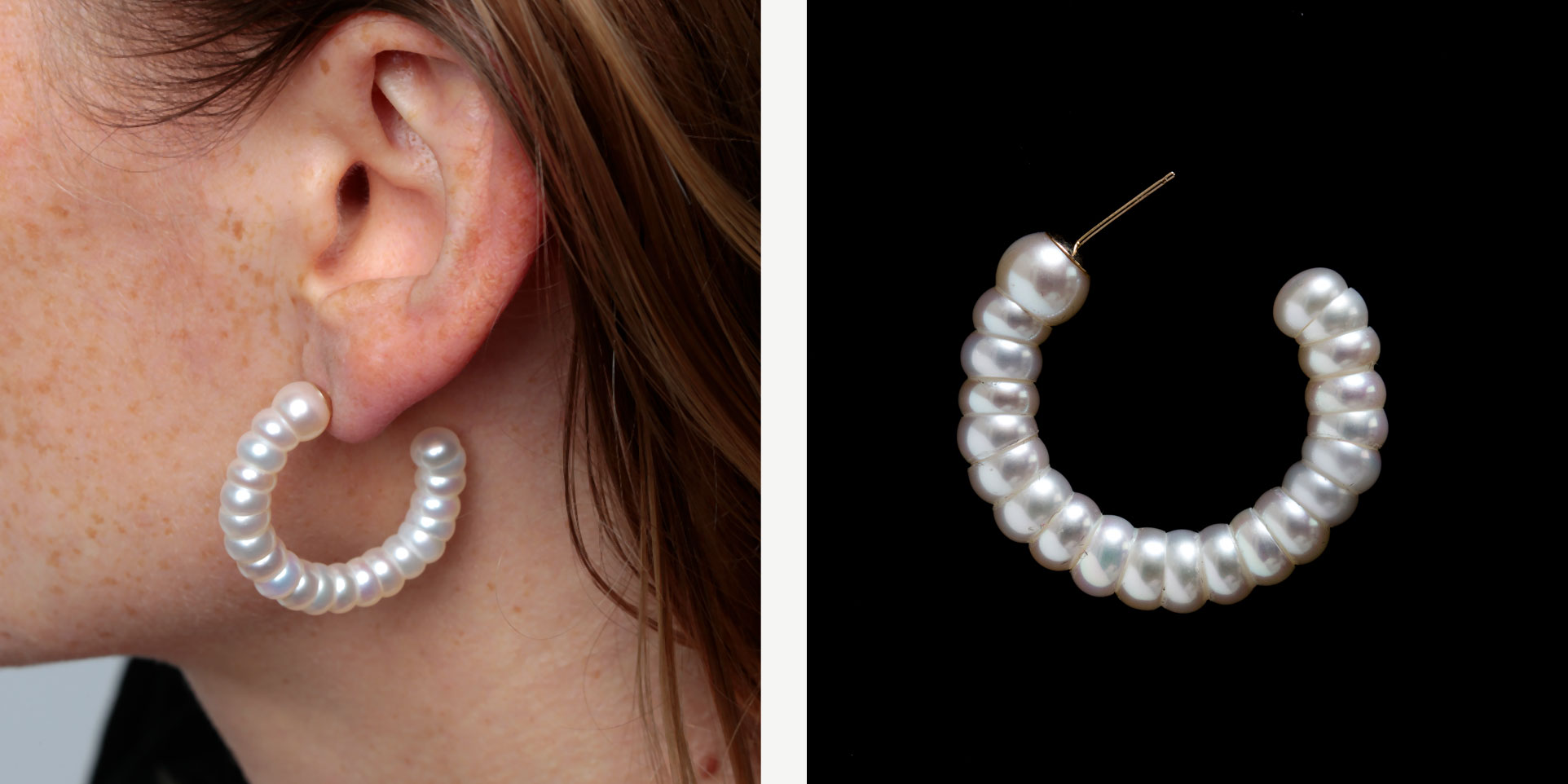
Images: Hoop, by Aidan Madden
Commenting on the award, Winterson's Creative Director Alice Cicolini said "We are delighted to celebrate Aidan's intensive investigation of the language of pearl jewellery. Our prize is for innovation with pearls and it was wonderful to see how many students really embraced that idea this year. It was Aidan's commitment to the gemstone as the starting point for his creative exploration that really stood out for us. We are excited to see where this journey takes him - and our perceptions of what a pearl jewel can be."
Each year the prize celebrates an appreciation and understanding of the qualities of the pearl. With such an original and diverse group of work this year, Aidan was an excellent winner. Congratulations Aidan!
Read more about Aidan Madden and the other CSM designers' work here.